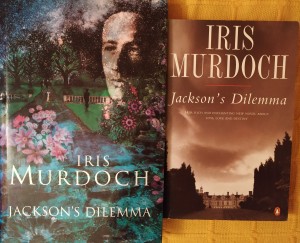 Well, it’s the last day of my 26-month Iris Murdoch Readalong and time to summarise our discussion of Jackson’s Dilemma and indeed the whole re-read. Which feels impossible right now.
Well, it’s the last day of my 26-month Iris Murdoch Readalong and time to summarise our discussion of Jackson’s Dilemma and indeed the whole re-read. Which feels impossible right now.
We had a good discussion of Jackson and his dilemma over on my review of the book, and I think it’s so lovely that Peter, Jo and Maria were there to talk about the book, as they have for EVERY SINGLE ONE all the way through. Jo was even reading them for the first time, and that’s amazing, to do the whole lot like that, isn’t it? Even I didn’t read all the ones that were available immediately upon discovering IM!
Jo has done her usual excellent Goodreads review and as ever, if you are coming to this outside the original project in 2017-2019, please do add comments or links to your reviews, I always love seeing them!
Peter has been amazing at sharing cover images of his copies of the book – mainly US first editions but also some excellent paperbacks. Here’s his first edition of Jackson, very like my paperback but with a nice filigree effect on the background to the title.
Project round-up
What have I learned this time around – which was at least my fourth read of each novel apart from Jackson’s Dilemma, which was my third?
There is more feminism than I ever thought was in there
I am now older than most of the main characters in the book. As I’ve read them again and again, I’ve become more understanding of the older characters, more impatient with the younger ones
Some books have slightly dropped in my estimation – I was rather horrified at the violence in “A Word Child”, for example. I was more reconciled than ever to “An Unofficial Rose”, which I have always thought one of my less favourites, and got a lot more out of “The Message to the Planet” than on other occasions, so that I won’t actively dread reading it another time.
I think that “The Philosopher’s Pupil”, “A Severed Head”, “The Book and The Brotherhood” and “The Green Knight” remain my favourites. The others have evened out more, though. Jenkin Riderhood is probably still my favourite character, along with N from “Philosopher’s Pupil” (still).
Having read them all the way through in my 20s, 30s and 40s, I can’t wait to read them all again in my next decade – so in 2022 at the earliest. IM is still my favourite author and I will still press her upon people – and now I have this great wellspring of discussion to point people towards.
I have loved doing the project “live” on my blog this time around and thank everyone who has contributed in whatever way, but especially my three stalwarts. If you have found this blog via IM, I hope you stay around to talk about other books here.
What’s your favourite so far? Your least favourite? Do you have a photo to share of you reading one of the books, or where you read it?
You will find a page listing all of these blog posts here.










Recent comments